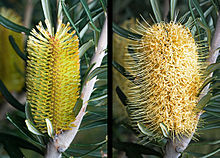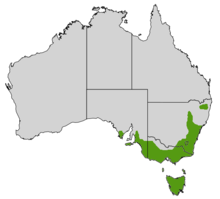
Back بنكسية هامشية Arabic بانكسيا هامشيه ARZ Banksia marginata Azerbaijani Banksia marginata CEB Banksia marginata Spanish Banksia marginata French Banksia marginata ID Banksia marginata Italian Banksia marginata Dutch Banksia marginata Portuguese
| Silver banksia | |
|---|---|

| |
| Inflorescence with unopened buds (left), opened flowers (right) | |
| Scientific classification | |
| Kingdom: | Plantae |
| Clade: | Tracheophytes |
| Clade: | Angiosperms |
| Clade: | Eudicots |
| Order: | Proteales |
| Family: | Proteaceae |
| Genus: | Banksia |
| Species: | B. marginata
|
| Binomial name | |
| Banksia marginata | |

| |
| Distribution of B. marginata across southeastern Australia | |
| Synonyms[2] | |
Banksia marginata,[2] commonly known as the silver banksia, is a species of tree or woody shrub in the family Proteaceae found throughout much of southeastern Australia. It ranges from the Eyre Peninsula in South Australia to north of Armidale, New South Wales, and across Tasmania and the islands of Bass Strait. It grows in various habitats, including Eucalyptus forest, scrub, heathland and moorland. Banksia marginata varies widely in habit, ranging from a 20-centimetre (7.9 in) shrub to a 12-metre (40 ft) tree. The narrow leaves are linear and the yellow inflorescences occur from late summer to early winter. These flower spikes fade to brown and then grey and develop woody follicles bearing the winged seeds. Originally described by Antonio José Cavanilles in 1800, further collections of B. marginata were designated as several separate species by Robert Brown in 1810. However, all were reclassified as a single species by George Bentham in 1870. No distinct subspecies have been recognised by Banksia expert Alex George, who nonetheless concedes that further work is needed.
Many species of bird, in particular honeyeaters, forage at the flower spikes, as do native and European honeybees. The response to bushfire varies. Some populations are serotinous: they are killed by fire and regenerate from large stores of seed, which have been held in cones in the plant canopy and are released after a fire. Others regenerate from underground lignotubers or suckers from lateral roots. Although it has been used for timber, Banksia marginata is most commonly seen as a garden plant, with dwarf forms being commercially propagated and sold.
- ^ Forster, P.; Ford, A.; Griffith, S.; Benwell, A. (2020). "Banksia marginata". IUCN Red List of Threatened Species. 2020: e.T112527605A113306651. doi:10.2305/IUCN.UK.2020-2.RLTS.T112527605A113306651.en. Retrieved 27 October 2021.
- ^ a b "Banksia marginata". Australian Plant Name Index (APNI), IBIS database. Canberra, Australian Capital Territory: Centre for Plant Biodiversity Research, Australian Government. Archived from the original on 2 June 2011. Retrieved 19 November 2012.
© MMXXIII Rich X Search. We shall prevail. All rights reserved. Rich X Search
